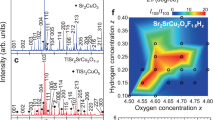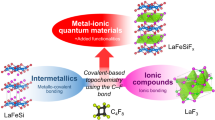Abstract
HIGH-PRESSURE synthesis has proved a useful technique for obtaining new, metastable copper oxide superconductors; for example, oxygen insertion into Sr2CuO3 at 6 GPa (ref. 1) yields superconducting Sr2CuO3.i, with transition temperature Tc = 70 K, in which the superconducting CuO2 layers are generated by pressure-induced oxygen migration from apical to equatorial sites. Although the simple structure and high transition temperatures make this family (general formula Srn+1CunO2n + 1+ δ) of interest, the stringent synthesis conditions limit its value for applications. Here we report that fluorine insertion into Sr2CuO3 at ambient pressure causes related structural rearrangements to give superconducting Sr2CuO2F2 + δ with a maximum Tc of 46 K. In this synthesis, the structural changes previously initiated by the thermodynamic effects of high pressure are induced chemically under ambient conditions. The result is a superconducting oxy-fluoride in which fluorine plays a dominant structural role, rather than merely being an electronic dopant as in La2CuO4Fx (ref. 2) and Nd2CuO4−xFy (ref. 3).
This is a preview of subscription content, access via your institution
Access options
Subscribe to this journal
Receive 51 print issues and online access
$199.00 per year
only $3.90 per issue
Buy this article
- Purchase on Springer Link
- Instant access to full article PDF
Prices may be subject to local taxes which are calculated during checkout
Similar content being viewed by others
References
Hiroi, Z., Takano, M., Asuma, M. & Takeda, Y. Nature 364, 315–317 (1993).
Tissue, B. M., Cirillo, K. M., Wright, J. C., Daeumling, M. & Larbalestier, D. C. Solid St. Commun. 65, 51–54 (1988).
James, A. C. W. P., Zahurak, S. M. & Murphy, D. W. Nature 338, 240–241 (1989).
Karpinski, J., Kaldis, E., Jilek, E., Rusiecki, S. & Bucher, B. Nature 336, 660–662 (1988).
Okai, B. Jap. J. appl. Phys. 29, L2180–L2182 (1990).
Sleight, A. W. Chemtronics 2, 116–119 (1987).
Lobo, R. C., Berry, F. J. & Greaves, C. J. Solid St. Chem. 88, 513–519 (1990).
Belcher, R. & Nutten, A. J. Quantitative Inorganic Analysis 3rd edn 281 (Butterworths, London, 1970).
Campbell, A. M., Blunt, F. J., Johnson, J. D. & Freeman, P. A. Cryogenics 31, 732–734 (1991).
Chaillout, C. et al. Physica C158, 183–191 (1989).
Radaelli, P. G. et al. Phys. Rev. B48, 499–510 (1993).
Brown, I. D. & Altermatt, D. Acta Crystallogr. B41, 244–247 (1985).
Weenk, J. W. & Harwig, H. A. J. Phys. Chem. Solids 38, 1047–1054 (1977).
Author information
Authors and Affiliations
Rights and permissions
About this article
Cite this article
AI-Mamouri, M., Edwards, P., Greaves, C. et al. Synthesis and superconducting properties of the strontium copper oxy-fluoride Sr2CuO2F2+δ. Nature 369, 382–384 (1994). https://doi.org/10.1038/369382a0
Received:
Accepted:
Issue Date:
DOI: https://doi.org/10.1038/369382a0
This article is cited by
-
Electrostatic gating and intercalation in 2D materials
Nature Reviews Materials (2022)
-
Calcium-free double-layered cuprate superconductors with critical temperature above 100 K
Communications Materials (2021)
-
Superconductivity over 30 K of Nd2CuO4 Films on CaF2 Substrates
Journal of Superconductivity and Novel Magnetism (2020)
-
Superconductivity of a cuprate with compressed local octahedron
Science China Physics, Mechanics & Astronomy (2019)
-
Expanding frontiers in materials chemistry and physics with multiple anions
Nature Communications (2018)
Comments
By submitting a comment you agree to abide by our Terms and Community Guidelines. If you find something abusive or that does not comply with our terms or guidelines please flag it as inappropriate.



